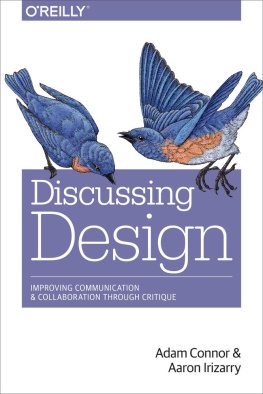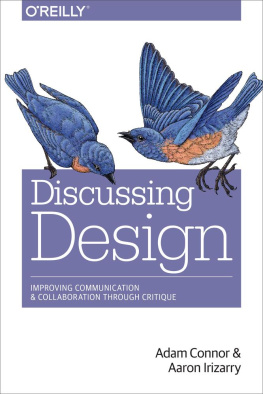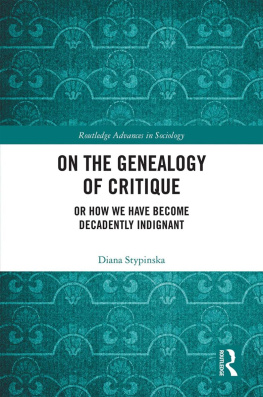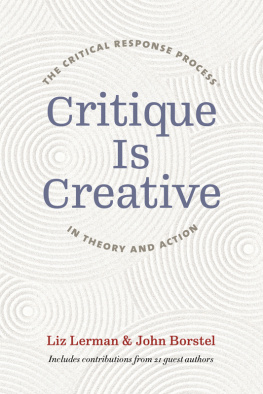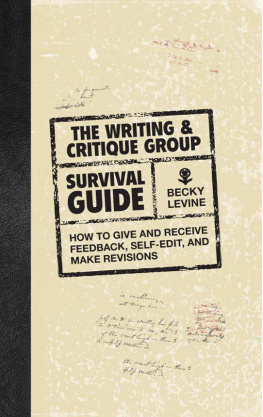Discussing Design: Improving Communication and Collaboration Through Critique
Adam Connor
Aaron Irizarry
Beijing Cambridge Farnham Kln Sebastopol Tokyo
Special Upgrade Offer
If you purchased this ebook directly from oreilly.com, you have the following benefits:
DRM-free ebooksuse your ebooks across devices without restrictions or limitations
Multiple formatsuse on your laptop, tablet, or phone
Lifetime access, with free updates
Dropbox syncingyour files, anywhere
If you purchased this ebook from another retailer, you can upgrade your ebook to take advantage of all these benefits for just $4.99. to access your ebook upgrade.
Please note that upgrade offers are not available from sample content.
Foreword
Critique requires an investment.
This investment certainly comes from the person who provides the critique; he has an obligation upon accepting the request to provide you with an ability to act and/or react to his input. (There is a bit of beauty here in that you get to decide how to act and/or react to his input, and that can be to do nothing with it. You should, of course, be prepared to explain why you did nothing with it.)
Your investment (and your responsibility), however, is much, much greater. It is you who are obligated to set up your audience to provide you the critique that you want and need through a structured request. It is you who needs to provide people a proper contextthe scope and goals for the critiqueto set the proper expectations and to frame the critique that allow you to explore possible improvements.
This might sound simple enough; however, the reality is that most people dont operate under any formal rules of critique. Instead, a lot of times designs are shared over email, through project management software or other design-sharing services, in chat, or through other rather narrow communication channels. Reactions and responses turn up in Reply All bullet points, fragments of disjointed and combined discussion threads, and even worse, piecemeal over a period of time.
Indeed, hell can be other people.
In many cases, were to blame.
Designers have to not only respond and react, they also have to try to organize and coordinate discussions, thoughts, and debates and then try to iterate. And then, the process is repeated again (and sometimes again, and again) as a new draft is sent around again, bereft of context or explanation of whats been updated.
This is time consuming and fraught with potential mistakes and out-of-scope requests. And, for the love of all things holy, think of the timelines and budgets!
Unfortunately, this really isnt uncommon. Its possible that you were just nodding your head in agreement while you were reading that, thinking of that one project that was such a tremendous pain at that one employer where the client, the boss, and everyone else were so impossible to work with. I get it. Ive been there in the thick of that trap, and Ive perpetuated it, too.
It doesnt have to be any of these ways, and picking up this book is your first step toward ensuring that those vicious cycles stop happening aroundor worse, because ofyou. The most successful designers know that good, structured critique guides them through the design process and helps them to produce their best work. They know that they bear the burden of ensuring they get what they need from others involved in the project in order to make a design work, and they know that this helps make it a lot easier to sell their work to their clients.
Read this book. Read every last page of its critique-detailing goodness. And then apply it to your design practice. Youll make some mistakes along the way; however, youll also find yourself improving at critique from your very first attempt. Before you know it, you wont consider any other way to create your best work.
Adam and Aaron are two of the best designers I know, and this is largely due to their focus on unlocking the vault that holds all the secrets to good, structured critique. Theyre not only great designers, theyre also kind and generous souls who are sharing all that theyve learned with us so that we, too, can be better designers and serve our clients and our purpose as best as we can.
Ive been luckyIve been able to witness Aaron and Adam as theyve gone through the exploration of critique. What started as a joint presentation turned into a website. That then turned into workshops at some of the best-known conferences around the globe, which then turned into a detailed book proposal, which finally turned into the book youre holding in your hands. Ive learned so much along the way, and Ive improved my own practices and approach to design critique along the way. Ive been able to work with teams where we invested a very small percentage of our time in critique and in turn felt that the investment was returned incrementally. Ive put their practices into use in the practice of design and also in content creation, presentations, teaching, and more.
This critique stuff works.
This book is a lot like reliving Adam and Aarons journey for me, and its a reminder of all the things that I can still do better through the practice of proper critique. I look forward to hearing your stories about how critique has helped change and improve all that you do, too.
RUSS UNGER
JANUARY 2015
Preface
The Lost Skill of Critique
Make it pop some more.
I dont really like it... I am not sure why, but this isnt it... Ill know it when I see it.
What the hell is this?
Can you make it look like Apple?
You should move that text to the top of the page and make all of the buttons icons.
If you have spent any time building, designing, or crafting somethingor working with those who doyou have probably heard something along the lines of these statements, which are often followed by something like, Well, Im just giving you some feedback.
Or, perhaps you were part of a program in school that included critique where your professor tried to break you down for your own good. Although this is not the situation in all academic settings, some schools and educators use critique and feedback sessions as a way to prepare students for the real world, but often they just leave students upset and with some bad memories.
There is a lot of ambiguity around feedback and why we share it with others. When feedback lacks a focus and appropriate purpose it is counterproductive and can even be harmful at times. Even in social interactions we see this type of feedback being used to express opinions. So often, when a new product is released or updated, before you know it the masses are providing 140 characters of opinion about what should have been done or created.
The more we hear stories (and experience situations ourselves) of out-of-context opinions, harsh phrases, and directional statements shared as feedback, weve seen that the real value and utility of feedback as part of design and creative processes being lost.
In short, weve forgotten how to critique. Because of thisand because of how feedback often is usedwe harm not only the products and services we create, but our teams, organizations, and working relationships, as well.
Critique is supposed to be helpful. It should be an analysis that helps us understand what is working and what isnt and whether we are on the right track toward reaching our goals. But the critique and feedback we see in so many teams doesnt do this. Instead its often used as a way for individuals to assert their own authority or push their own perspectives and objectives. It could be someone trying show expertise to others in the room by pointing out all of a designs faults without the real intention to help the design get better. I have also seen individuals pick a design apart as a way to eliminate any competition between the design being reviewed and their design.

